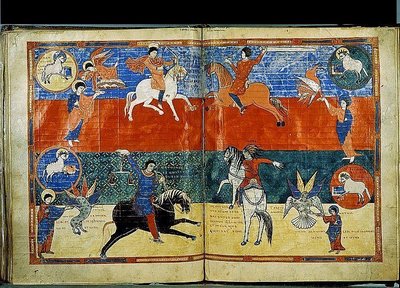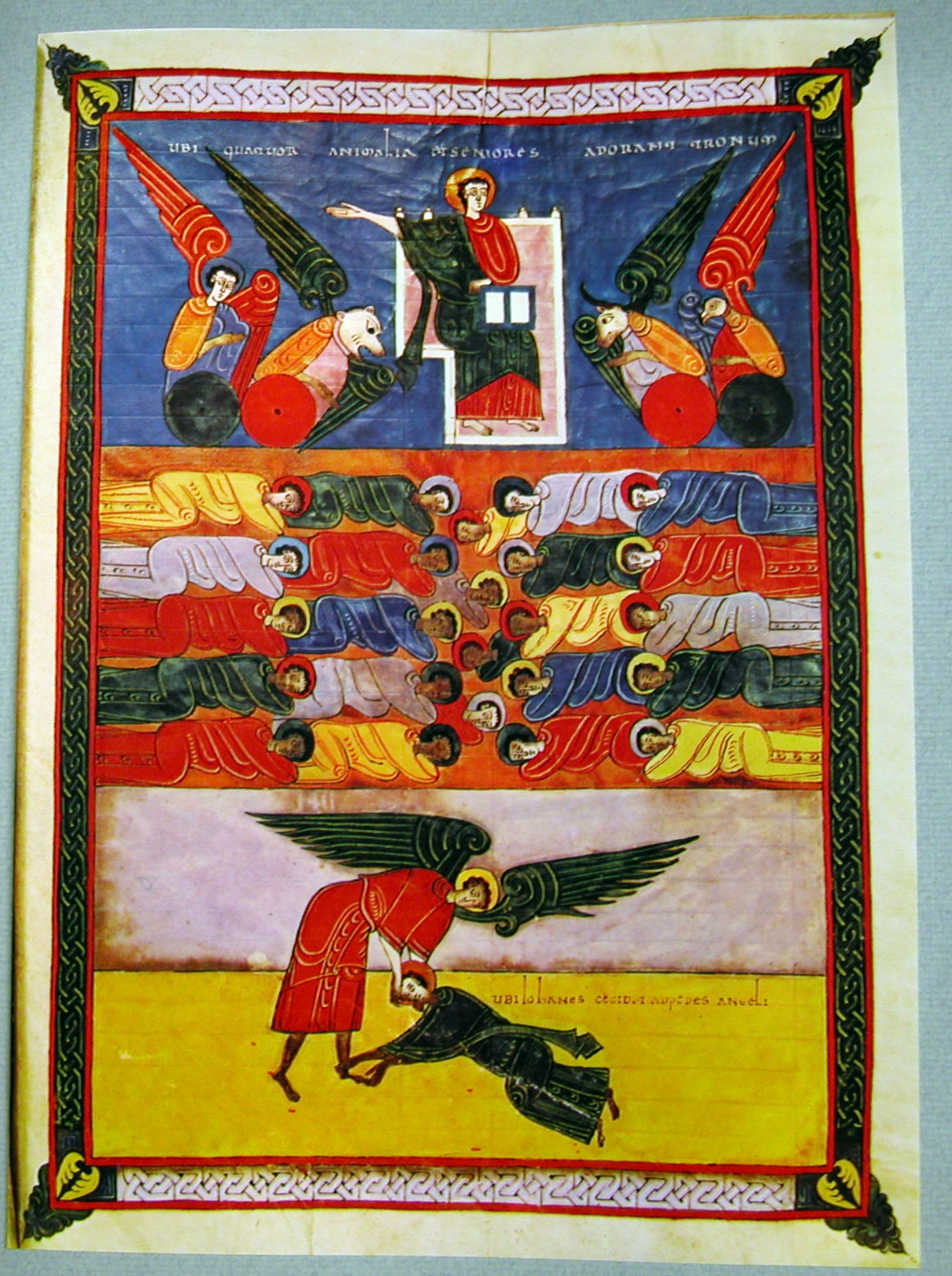Illumination of the Prayer of Dona Ximena in the Poem of El Cid by Alana Kelley, student at Thomas More College
 An original work of art in the Spanish Romanesque style of the Morgan Beatus Manuscript. My colleague at Thomas More College Dr Christopher Blum called me into his office the other day. He was keen to ask my opinion on a piece of art work handed in by student, Alana Kelley for his medieval literature class. He showed me the manuscript shown left. I immediately recognized this as the Spanish, Romanesque style as exemplified in the 10th century Morgan Beatus manuscript. She has created an original work of art in this style to illustrate the Spanish classic poem of El Cid. There are some examples of the Spanish illuminations below.
An original work of art in the Spanish Romanesque style of the Morgan Beatus Manuscript. My colleague at Thomas More College Dr Christopher Blum called me into his office the other day. He was keen to ask my opinion on a piece of art work handed in by student, Alana Kelley for his medieval literature class. He showed me the manuscript shown left. I immediately recognized this as the Spanish, Romanesque style as exemplified in the 10th century Morgan Beatus manuscript. She has created an original work of art in this style to illustrate the Spanish classic poem of El Cid. There are some examples of the Spanish illuminations below.
Alana is a gifted artist who has now attended two icon painting classes of mine at the college and devoted a semester of Saturdays learning academic drawing at the Ingbretson Studio. What is particularly gratifying for me is how intelligently she has made use of the techniques she had learnt and produced something that is in harmony with literature she is studying. In regard to this particular piece it was all without any input from me at all – it was submitted at part of a medieval literature class, not an art class.
Dr Blum told me: ‘It was in response to an assignment that invited the students to create an original work of art modeled upon or inspired by the medieval texts that we studied. As well as Alana’s painting there were a number of conventional essays submitted, but also four lengthy poems, three plays, two paintings, two illustrated books, two recitations (from memory, of course) of medieval verse, one performance of medieval songs, and an original piano sonata inspired by the First Crusade's Liberation of Jerusalem. What most impressed me about the whole class's response to the assignment is that they plainly understood that the cultural achievements of the past are not museum pieces meant to be dead on a wall, but living works, continually inspiring our own reflection upon the good, the true, and the beautiful.
‘As to Alana's painting: I was especially delighted in her choice of theme, because the prayer of Dona Ximena in the Poem of El Cid is, to my mind, one of the most stirring examples of the way in which the Christian faith shaped the imagination of our medieval ancestors. The prayer places the human drama in the context of the whole of salvation history and the divine order of the universe, and Miss Kelley's manuscript, by making the text of the prayer a kind of link or middle between the celestial and the earthly realms, reflects the deep Christian identity of the anonymous Castilian poet who left us the Cantar de Mio Cid.’
Looking at it with my artist’s eye, what struck me is how Alana has adopted the compositional style of the Beatus and used orthogonal division of the space. The practicalities of the class meant that she had to work in acrylic, but she investigated additives that would allow her to paint glazes (a dark transparent layer over a lighter) in order to get the effects that I had shown her using egg tempera in the icon painting class. By using successive glazes she has introduced subtle variety and interest into areas that would otherwise by flat monochrome; and by varying the local contrast, for example around the script and around the figures, she has ensured that the eye is drawn to the most important aspects of the composition. The patterned border is typical of Romanesque work and not seen in Eastern icons so often but, again, wholly appropriate for this work.

Alan Kelley's illumination, above, and, below, examples of Romanesque illuminations from the period

